|
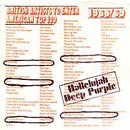 Hallelujah Hallelujah
"ALTHOUGH it's had a couple of big ones in the States,
Deep Purple has yet to register here at home. And it's just
possible that this could do the trick - it's one of those
numbers that could either be a smash hit or a massive flop!
Penned by the Greenaway-Cook team, it's a medium-pacer with
a strong gospel-revivalist flavour. lan Gillan delivers
the preacher-like lyrics effectively, though I could have
done without the screams, while the bluesy organ and strident
guitar maintain an atmospheric backcloth. A disc that's
laden with mystique and compulsion, and which - in its more
inspired moments - develops a rock-like quality."
(week ending August 2nd 1969, NME)
|
|
IN
ROCK
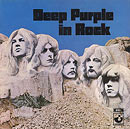 "A
stunningly good album from a group that proves several things
on it: 1/ That rock, given a fresh stab and alert material,
is still one of the most rewarding areas of contemporary
music. 2/ That it need not all be frenzy, but can also reach
out and project a message when it's cool and wistful. 3/
That Ritchie Blackmore is not merely a fast guitarist, but
one with immense style and presence. The recording quality
here is so good that, perhaps for the first time, the textures
of some fine instrumentalists, and let's not forget a powerrful
singer, are given the correct emphasis. On "Child In Time"
lan Gillan's blistering vocal, moralising in too general
terms about the State Of Things, is matched only in style
by Blackmore's masterly guitar work which is completely
in context. His sympathy with the mood of each work throughout
this album is quite remarkable. Jon Lord's exciting work
at the organ is another strength and as a unit they are
perfectly integrated. A magnificent album, which no enthusiast
of today's music dare miss." "A
stunningly good album from a group that proves several things
on it: 1/ That rock, given a fresh stab and alert material,
is still one of the most rewarding areas of contemporary
music. 2/ That it need not all be frenzy, but can also reach
out and project a message when it's cool and wistful. 3/
That Ritchie Blackmore is not merely a fast guitarist, but
one with immense style and presence. The recording quality
here is so good that, perhaps for the first time, the textures
of some fine instrumentalists, and let's not forget a powerrful
singer, are given the correct emphasis. On "Child In Time"
lan Gillan's blistering vocal, moralising in too general
terms about the State Of Things, is matched only in style
by Blackmore's masterly guitar work which is completely
in context. His sympathy with the mood of each work throughout
this album is quite remarkable. Jon Lord's exciting work
at the organ is another strength and as a unit they are
perfectly integrated. A magnificent album, which no enthusiast
of today's music dare miss."
(1970, UK music paper)
|
|
FIREBALL
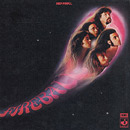 "DEEP
PURPLE have the disadvantage of having to live up to a reputation,
but they'll have no worries with 'Fireball'. They also have
to keep up a stream of good sounds, while fending off attempts
by other groups to pick their brains and musical originality.
They'll manage that too. With the exception of one back,
'Fireball' is undiluted, funky Purple. The exception, a
sad inclusion to an othenwise extremely good album, is 'Anyone's
Daughter'. Ian Gillan's vocals aren't really suitable for
Dylanesque talking blues, and as the words come close to
banal, the whole number just comes over as a send up. If
it was intended as such, it seems an awful waste of time
and effort. "DEEP
PURPLE have the disadvantage of having to live up to a reputation,
but they'll have no worries with 'Fireball'. They also have
to keep up a stream of good sounds, while fending off attempts
by other groups to pick their brains and musical originality.
They'll manage that too. With the exception of one back,
'Fireball' is undiluted, funky Purple. The exception, a
sad inclusion to an othenwise extremely good album, is 'Anyone's
Daughter'. Ian Gillan's vocals aren't really suitable for
Dylanesque talking blues, and as the words come close to
banal, the whole number just comes over as a send up. If
it was intended as such, it seems an awful waste of time
and effort.
Now for the good news, and that's the remaining
six tracks. While they an different in musical and lyrical
content, they have kept an identifiable theme running through
with strong organ and bass lines from Jon Lord and Roger
Glover. For arrangement and all over goodness, 'Fools' is
half a head in front. Emotive searing words are fitted to
a tight drum/guitar accompaniment, with a plaintive organ
backing soaring through it all.
Again with the accent on the words, 'No One
Came' follows a close second. The songs all seem rather
bitter-sweet, but create good feelings all the same
Quality-very good. Value for money-yes, definitely."
(1971, Disc)
|
|
MADE
IN JAPAN
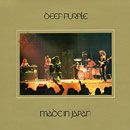 "Just
like its magnificent predecessor "Machine Head", this double
album, which captures Deep Purple at their very best in
the Land Of The Rising Sun, more than substantiates the
undisputed truth that they're one of the few groups who
have managed to combine creative intelligence with complex
high-energy electric rock. "Just
like its magnificent predecessor "Machine Head", this double
album, which captures Deep Purple at their very best in
the Land Of The Rising Sun, more than substantiates the
undisputed truth that they're one of the few groups who
have managed to combine creative intelligence with complex
high-energy electric rock.
Following in the grand tradition of great British
rock bands, the Purple Gang - perhaps, even more so than
ELP - have in their own inimitable way extended the early
experiments of The Nice. However, in no way are Deep Purple
plagiarists, they are what they play, and that's the reason
why they enjoy mass acceptance. Purple have two major assets
that The Nice lacked - an exceedingly professional full-lunged
front man in lan Gillan, and the greased- lightnin' digital
gymnastics of guitarist Richie Blackmore.
In many ways, a "live" album is the best media
for any first-class road band to present their music. Even
though there can be faults in balance and mix, you can still
judge the band for what they're worth. This particular album
- worth double the price - will consolidate Purple's enviable
position and convert many new fans. Though each is a virtuoso,
neither Jon Lord, lan Paice, Roger Glover, Gillan or Blackmore
allow their individual skffls to get out of hand and detract
from the collective performance.
You may have heard all seven cuts before -
but not played with such power, exuberance and sheer confidence.
This power is largely boosted by the responsive
audiences Purple played to in both Tokyo and Osaka. Indeed,
half the enjoyment is in the two-way rapport between band
and fan.
To Purple's credit you don't need to dissect
every track, because they maintain such a high standard
of performance throughout. I detect a new-found funki- ness
in their intense drive. Jon Lord improves with each and
every album - his keyboard dexterity is clear and precise
even in the extremely fast passages. He disciplines himself,
never allowing his playing to deteriorate into a meaningless
jumble.
With brash confidence and showmanship, Richie
Blackmore wields his axe, in a manner the makers didn't
account for. He extracts a whole spectrum of discordant
effects and runs his fingers over the strings with incredible
speed.
As a unit Glover and Paice come on strong,
fortifying the front line and also having individual work
outs. Little lan's drumnastics on "The Mule" are much more
than "just another" drum solo.
With such competition, one doesn't envy lan
Gillan's position as singer, yet it never becomes a pitched
battle between who can sing/play louder than the other.
Gillan's delivery of "Highway Star", "Child In Time" and
"Strange Kind Of Woman" elevates him to the exclusive front
man fraternity of Stewart, Jagger, Rodgers, Plant, and Daltrey.
When reviewing albums, I always work on the
maxim, "Would I Buy This Record". As far as Deep Purpte's
'Made In Japan' is concerned, I have no hesitation in saying
YES."
(1972, UK music paper)
|
|
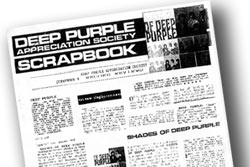 All
of these reviews are selected from the All
of these reviews are selected from the
DEEP PURPLE APPRECIATION SOCIETY 'SCRAPBBOOK 4 - RECORD
REVIEWS';
sixteen
pages containing over 100 contemporary newspaper and magazine
reviews covering Deep Purple releases from 1968-1982
.It
is available exclusively from the
dpas online store.
|
|
|
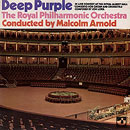 CONCERTO CONCERTO
"THIS
is the LP recorded live at that sensational concert last
summer, when Deep Purple combined with The Royal Philharmonic,
under the energetic baton of Malcolm Arnold, to try and
prove that pop and classical music need not be poles apart.
The reaction to the concert at the Albert Hall was one of
immense satisfaction and admiration, but it met with luke-warm
receptions from the 'heavy critics."
So,
it is not unreasonable to suppose this album will go the
same way. In three very varied movements organist Jon Lord,
who wrote the entire work, takes the group and orchestra
through the stages of combatants, touch-and-run lovers and
finally a rousing, spirited free for all.
The
evening was fun, and the album can't hope to capture the
incredible atmosphere, but to the thousands who loved the
music, this very fine LP will be a must. And for those who
didn't attend, you'll be able to find out exactly what you
missed." (December 20th 1969, NME)
|
|
Black
Night
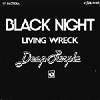 "The
Deep Purple record is really good. It's about time groups
like this had a look in the chart. Up to now it's been all
Tamla and bubblegum that's made the chart." "The
Deep Purple record is really good. It's about time groups
like this had a look in the chart. Up to now it's been all
Tamla and bubblegum that's made the chart."
(Ozzy Osbourne,
1970 UK music paper)
|
|
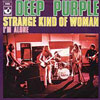 Strange
Kind Of Woman Strange
Kind Of Woman
"Deep
Purple aren't the sort of band you use words like 'commercial'
about, but this track is, surprisingly, exactly that. Written
by the band it's a very interesting controlled track instrumentally
with a very familiar repetitious melody line and a really
good slow middle break. The guitar parts work in a very
complementary way to the whole feel of the record and I
wouldn't be a bit surprised to find Deep Purple at the top
of the singles chart - which is a thought." (Sounds,
1971)
|
|
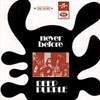 Never
Before Never
Before
A powerful effort from the Purple ones, but it doesn't have
the distinction needed for a hit single. Neat guitar from
Ritchie and hip drums from lan keep it cooking behind lan
Gillan's vocals." (1972, UK music paper)
|
|
MACHINE
HEAD
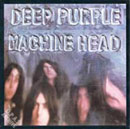 "
If some berk hadn't decided to play ship in distress and
let off a flare gun during.a Mothers concert in the Casino,
Montreux, what we'd have here would be a double album instead
of a single in a double sleeve. But as it is we've got to
make do with what we've got and what we've got is a lot.
After the phenomenal run of success of "Deep Purple In Rock",
the band didn't quite match it with "Fireball", so they
obviously wanted to come out with another winner. They have.
The Stones' mobile recording unit was lugged from the South
of France to Montreux and the original plan was for Purple
to record two albums in the Casino - one a straight studio
set and the other a simulated concert. Old fire fingers
put an end to all that. Side One starts with
"Highway Star", written by lan Gillan in a coach en route
to a gig in Portsmouth last year. The number has a chuggin'
rock and roll beat with no frills. There's an electric piano
solo using chord progression and later a lead guitar solo
followed the same pattern - it's probably one of the best
solos Richie Blackmore's ever played. "
If some berk hadn't decided to play ship in distress and
let off a flare gun during.a Mothers concert in the Casino,
Montreux, what we'd have here would be a double album instead
of a single in a double sleeve. But as it is we've got to
make do with what we've got and what we've got is a lot.
After the phenomenal run of success of "Deep Purple In Rock",
the band didn't quite match it with "Fireball", so they
obviously wanted to come out with another winner. They have.
The Stones' mobile recording unit was lugged from the South
of France to Montreux and the original plan was for Purple
to record two albums in the Casino - one a straight studio
set and the other a simulated concert. Old fire fingers
put an end to all that. Side One starts with
"Highway Star", written by lan Gillan in a coach en route
to a gig in Portsmouth last year. The number has a chuggin'
rock and roll beat with no frills. There's an electric piano
solo using chord progression and later a lead guitar solo
followed the same pattern - it's probably one of the best
solos Richie Blackmore's ever played.
"Maybe I'm A Leo" is an undistinguished piece
taken at a heavy, plodding pace and "Pictures Of Home" returns
to rock and roll. Some twiddly bits of guitar playing and
another Blackmore solo highlighting the number, which was
written in Switzerland during the session. Gillan's voice
shows few signs of its previous strain.
"Never Before" winds up the first side with
lan Paice's thumping drum beat disguising what is essentially
a sad song. Purple have a habit of staggering things by
building on or repeating chords and that technique is in
evidence here.
"Smoke On The Water" is the tale about the
whole scene in Montreux, and the title refers to the actual
fire that caused all the hassle. The heavy bass line gives
an air of gloom in keeping with the illustrative lyrics.
Listen to some pretty tasty drum work at the end.
"Lazy" is THE track for me. It's a showcase
for Blackmore's expertise and started off much shorter on
the last British tour. In Montreux, however, he worked on
it until it's become a lengthy demonstration of his power
within the band. Don t be fooled by the title, which doesn't
fit the tempo. Gillan's vocals are such that you feel he
might explode at any moment, and if you wait until after
his harmonica break you are almost literally rewarded.
It all ends with "Space Truckin' ". The words
make clever usage of the names of various planets and galaxies
on a funky piece of music that has the usual feature of
interplay between lead guitar and drums.
(1972, UK music paper)
|
|
WHO
DO WE THINK WE ARE
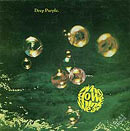 "I
was beginning to feel that Purple were getting too full
of themselves, especially after "Made In Japan." Thankfully
I was wrong and this album proves it, because it takes the
group right back to those hard riff days, which made them
one of the world's top bands. "Woman From Tokyo," the opening
track, unleashes the album in a characteristically solid
manner, although it does relent in pace to allow a fraction
of straight piano to work through. "Mary Long" is another
nifty rocker - garnished with some delightful lyrics. It
could well be directed at a certain clean- up campaigner.
"Super Trouper" is put across with slightly more freaky
mannerisms, atlhough like the following track, "Smooth Dancer,"
both cuts are loaded with exciting riffs that drive the
eardrums to distraction. "I
was beginning to feel that Purple were getting too full
of themselves, especially after "Made In Japan." Thankfully
I was wrong and this album proves it, because it takes the
group right back to those hard riff days, which made them
one of the world's top bands. "Woman From Tokyo," the opening
track, unleashes the album in a characteristically solid
manner, although it does relent in pace to allow a fraction
of straight piano to work through. "Mary Long" is another
nifty rocker - garnished with some delightful lyrics. It
could well be directed at a certain clean- up campaigner.
"Super Trouper" is put across with slightly more freaky
mannerisms, atlhough like the following track, "Smooth Dancer,"
both cuts are loaded with exciting riffs that drive the
eardrums to distraction.
Side two opens with some chunky guitar from
Blackmore on "Rat Bat Blue." It moves along at a terrific
rate and is one of the few tracks where Jon Lord gets a
chance of being heard. He goes from tinkling piano to wildly
driving organ - all in a thunderous conglomeration. In considerable
contrast we get a taste of Purple blues on a placidly sounding
"Place In Line," which has some pleasantly crisp guitar
from Blackmore. The album closes with a slower more electronic
"Our Lady". Gillan's voice sounds good as it does on the
whole album, while Lord's organ purrs and growls in alternating
patterns, until the track and album gradually fade away.
What an experience."
(1973, UK music paper)
|
|